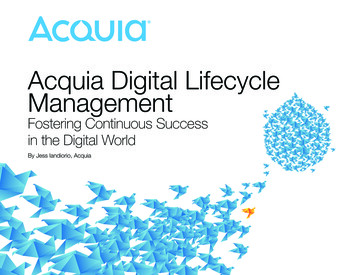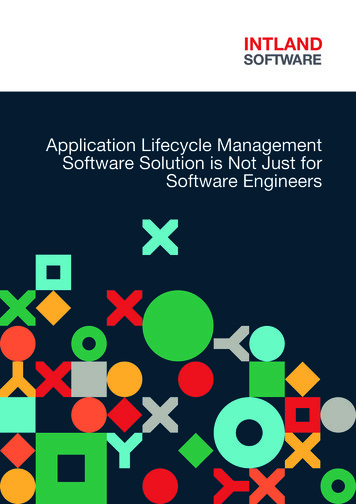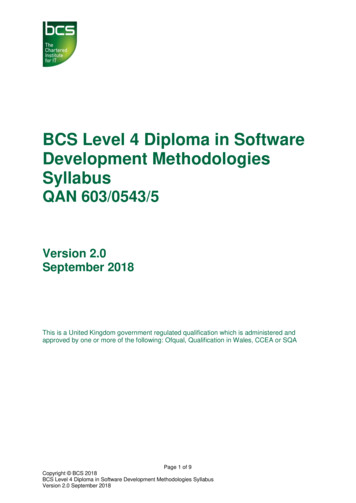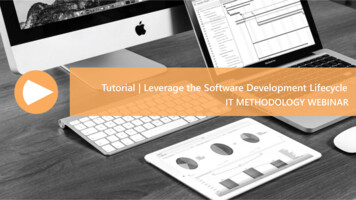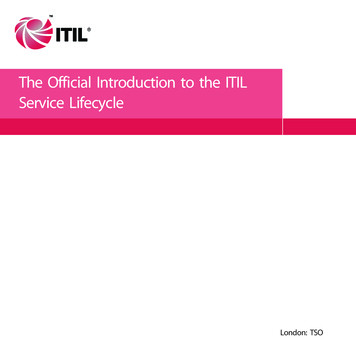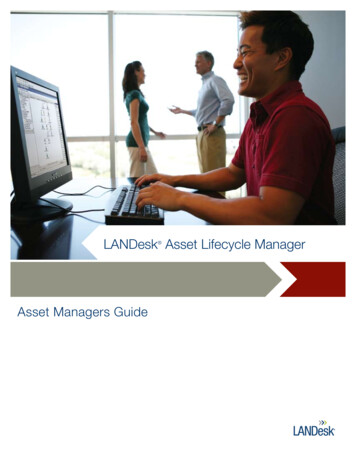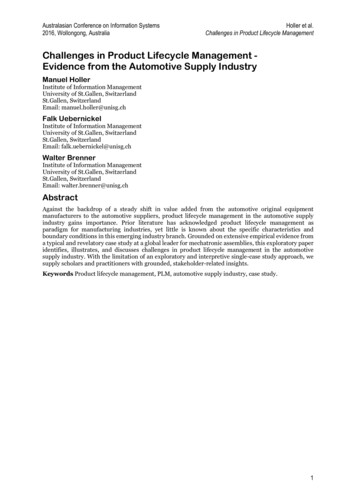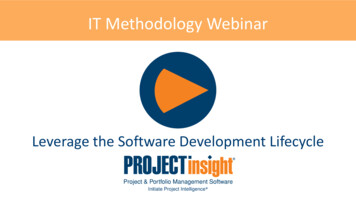
Transcription
IT Methodology WebinarLeverage the Software Development LifecycleInitiate Project Intelligence
Things to Know All participants will be on muteQuestions are welcomeAsk questions in the question boxWe DO NOT send out PDU certificatesMay be valid for PDU credit (self-report session) - For more information check out article on Webinars and PDUs and-pdus
ModeratorDenise RodriguezProject mwww.projectinsight.net
Project InsightSchedule a customized demo today! 1 (949) 476-6499 x3 info@projectinsight.net Request info: www.projectinsight.net
PresenterCameron WatsonPresident, QAIassistcwatson@qaiassist.comwww.qaiassist.com
Who’s on the call?I am a Project ManagerI am a Business or Operational ManagerI am a software developer or software testerI am a member of an organizational PMO, governance or qualityassurance functionI want a better understanding of IT Methodology
Who is QAIassist?Established 2007 – Ottawa, CanadaNurturing organizational efficiency through IT Methodology knowledge & expertiseSupport and promote a community with evolving IT Methodology knowledge and expertiseMaintain, optimize, promote and support the delivery of IT methodology products andlifecycles proven to increase operational performanceAdministration and oversight of QAIassist Integrated Methodology (QAIassist-IM) and formalcertifications – “Foundation” & “Practitioner”Support practitioners and authorized affiliates in acquiring and delivering IT Methodologyknowledge and expertise
IT Methodology Webinar AudienceNurturing efficiency through IT Methodology knowledge & expertise across the globe Over 200 countries Wide array of industries (manufacturing, banking, health, insurance, consulting) More than 50 unique webinarsOver 10,000 webinar registrants Executives Operational & Delivery Managers Project Managers Business Analysts and Architects Application Developers & Testers Corporate PMO, Quality Assurance, Continuous Improvement Consultants
QAIassist 2016 Series - GoalsShare IT Methodology knowledgeDevelop IT methodology understanding &expertiseProvide additional insight into several IT (projectmanagement, software development, softwaretesting) methodologiesDiscuss best practices on incorporating anorganizational IT methodologyPromote ongoing dialog and feedback withwebinar audience (questions, email, survey)
2016 ScheduleThe 3rd Wednesday of Every Month 8:00 am Pacific - 11:00 am Eastern TimeIT Methodology Concepts (60 mins) This series of six webinars will be presented on a bi-monthly basis. Each webinarwill provide you with a context, overview, terminology and general understandingof information technology (IT) methodology.IT Methodology – Tutorials (45 mins) This series of five webinars will be presented on a bi-monthly basis. Each session isdesigned to offer a more “hands on” perspective – bridging the concepts into apractical utilization.
2016 Concept SessionsThe 3rd Wednesday of Month (Jan, Mar, May, Jul, Sept, Nov) 8:00 am Pacific - 11:00 am Eastern TimeIT Methodology Concepts (60 mins) A Context for IT Methodology - (Jan)Apply PM Fundamentals to IT - (Mar)Leverage the Software Development Lifecycle - (May)Explore the Software Testing Lifecycle - (Jul)Incorporate Organizational Process Governance - ( Sept)Implementing IT Methodology - (Nov)
2016 Tutorial SessionsThe 3rd Wednesday of Month (Feb, Apr, Jun, Aug, Oct) 8:00 am Pacific - 11:00 am Eastern TimeIT Methodology Tutorials (60 mins) Applying IT Methodology to Project Initiation - (Feb)Project Planning & Design with IT in Mind - (Apr)Executing Projects with IT Methodologies - (Jun)Project Control & Verification - (Aug)Project Close & Delivery - ( Oct)
2016 Concept SessionsThe 3rd Wednesday of Month (Jan, Mar, May, Jul, Sept, Nov) 8:00 am Pacific - 11:00 am Eastern TimeIT Methodology Concepts (60 mins) A Context for IT Methodology - (Jan)Apply PM Fundamentals to IT - (Mar)Leverage the Software Development Lifecycle - (May)Explore the Software Testing Lifecycle - (Jul)Incorporate Organizational Process Governance - ( Sept)Implementing IT Methodology - (Nov)
Leverage the Software Development LifecycleConcepts IIIWebinar Goals Review previous IT Methodology Concepts Sessions (Jan, Mar) Define a context for Software Development Lifecycle (SDLC) Discuss significance of Requirements and Traceability Identify the purpose and objectives of SDLC phases
Leverage the Software Development LifecycleConcepts III - AgendaEstablish webinar context - review previous “Concepts” sessions Jan - A Context for IT Methodology Mar- Apply PM Fundamentals to ITSoftware Development Lifecycle (SDLC) – Context and PremiseSDLC - Requirements (Identification and Definition)SDLC Phases - Objectives, Iterations, TraceabilitySDLC – Internal Dynamics (PMLC and STLC interfaces)Recap
Leverage the Software Development LifecycleConcepts III - AgendaEstablish webinar context - review previous “Concepts” sessions Jan - A Context for IT Methodology Mar- Apply PM Fundamentals to ITSoftware Development Lifecycle (SDLC) – Context and PremiseSDLC - Requirements (Identification and Definition)SDLC Phases - Objectives, Iterations, TraceabilitySDLC – Internal Dynamics (PMLC and STLC interfaces)Recap
Terms, Terms and more TermsIT Framework, IT Methodology, IT Lifecycle Non Standard usage in terminology Terms are used interchangeably between organizations and across the IT industry Examples include Project ManagementMethodology/Lifecycle/Framework Software DevelopmentMethodology/Lifecycle (SDLC)/Framework Software TestingMethodology/Lifecycle/Framework Every IT organization is using an IT Methodology or IT Lifecycle or IT Framework
IT Methodology ContextOrganizational Frameworks ISO(900XXX), CMMI, Six-Sigma, ITIL, COBITMethodologies/Lifecycles (noun) Rational Unified Process (RUP), QAIassist(IM), PMI, Prince2Methodologies/Lifecycles (verb) Waterfall, Spiral, Agile, RAD, etc
IT Methodology ContextOrganizational Frameworks ISO(900XXX), CMMI, Six-Sigma, ITIL, COBITMethodologies/Lifecycles (noun) Rational Unified Process (RUP), QAIassist(IM), PMI, Prince2Methodologies/Lifecycles (verb) Waterfall, Spiral, Agile, RAD, etc
IT Methodology – Map & JourneyMethodologies/Lifecycles - “noun” The roadmap Rational Unified Process (RUP),QAIassist (IM) , PMI, Prince2Methodologies/Lifecycles - “verb” The journey taken along the road Waterfall, Spiral, Agile, RAD ,Prototyping, etc
IT Methodology/Lifecycle - NounAll Methodologies/Lifecycles (RUP, QAIassist-IM, PMI, Prince2) define, utilize andrely on their own pre-defined structure, naming conventions, and terminologyHierarchy/Structure Methodology/Lifecycle (ie Project Management, Software Development , Software Testing) Phase/Stage (ie Initiate, Planning, Design, Closeout) Deliverable/Artifact/Work Product (ie Project Charter, Testing Strategy) Activity (tasks performed to complete deliverables, artifacts, work products)
QAIassist Integrated Methodology
“Deliverable/Artifact/Work Product”versus “Activity”Building an IT ApplicationDeliverable (Artifact, Work Product) Business Case Project Plan User Acceptance Test PlanActivity (non-Deliverable, non-Artifact, non Work Product) Reviewing business need with Operational Management, Business Analysts and End-Users Meeting with Stakeholders to acquire approval of Project Plan Discussing User Acceptance Testing objectives and priorities with testing team
Deliverable/Artifact/Work ProductConstruct/FormatFixed Sections (always populated) Title Page Deliverable Details (Author, Creation Date, Version, Status, etc) Deliverable History, Reviewers, Sign Off Table of Contents (as per deliverable) Context (purpose of the deliverable)Variable Sections (based on pre-defined informational requirements) Structure/format defined as per deliverable (ie a Project Charter deliverable does nothave the same pre-defined informational requirements as a Testing Strategy deliverable)
Deliverable/Artifact/Work Product StatusDraft - Deliverable has been identified, assigned and is in the process of beingdrafted/completedReview - “Draft” deliverable has been completed and submitted for “review” and“authorization”Approved/Archived - “Reviewed” deliverable has been “Authorized” by designatedstakeholders and put under configuration managementApplied - Information within “Authorized” deliverable is being referenced and/or utilizedwithin another deliverable
“Deliverable/Artifact/Work Product” AttributesTangible (pre-defined informational requirements) Can be identified and defined (completion dates, cost) on Project Schedule Can be assigned (populating information requirements) to project team member(s) Can be referenced by project team members to support creation of other deliverables Can be formally reviewed and officially authorized Will alter in status (authored, reviewed, approved, archived, referenced) throughout life of project Will reflect evolving deliverable and project status/progress (risks, issues, percentage complete) Can be placed under formal configuration management – re: with evolving status Can be accessed for future reference (application support and maintenance)
Methodology Fundamentals 101Viable IT methodologies (noun and verb) are designed to help not hinderIT methodologies (noun) are applicable for a wide range of IT Methodologies (verb) anddelivery approaches (waterfall, spiral, agile, RAD, prototyping, etc)No hard or specific rules (ie iterations, frequency of iterations, deliverables to becompleted) of how an IT methodology (noun) can best be applied or leveraged by anorganization or project teamNo silver bullet - if the perfect combination of IT Methodology (noun) and ITMethodology (verb) existed, every project team and organization would be using it
Methodology Fundamentals 102Deliverables (and content) may be re-usable from one project to anotherNot every deliverable of every phase has to be completed for every project- any and every deliverable to be completed must add value (cost,schedule, quality) to the projectNot every section or sub-section of every deliverable has to be completedfor every project - information used to populate every deliverable must addvalue (cost, schedule, quality) to the project
QAIassist Integrated Methodology
Leverage the Software Development LifecycleConcepts III - AgendaEstablish webinar context - review previous “Concepts” sessions Jan - A Context for IT Methodology Mar- Apply PM Fundamentals to ITSoftware Development Lifecycle (SDLC) – Context and PremiseSDLC - Requirements (Identification and Definition)SDLC Phases - Objectives, Iterations, TraceabilitySDLC – Internal Dynamics (PMLC and STLC interfaces)Recap
Leverage the Software Development LifecycleConcepts III - AgendaEstablish webinar context - review previous “Concepts” sessions Jan - A Context for IT Methodology Mar- Apply PM Fundamentals to ITSoftware Development Lifecycle (SDLC) – Context and PremiseSDLC - Requirements (Identification and Definition)SDLC Phases - Objectives, Iterations, TraceabilitySDLC – Internal Dynamics (PMLC and STLC interfaces)Recap
SDLC – Business ContextDevelopment Environment New Products New Operational Business Applications (ie HR, Accounting, Sales, etc)Maintenance/Support Environment Existing Products Existing Operational Business Applications (HR, Accounting, Sales, etc) Off the Shelf Applications
SDLC – IT ContextMultiple IT Environments Mainframe, Distributed, Web BasedMultiple Delivery Approaches – Methodology (verb) Waterfall Agile PrototypingIntegrations Project Management Lifecycle Software Testing Lifecycle
SDLC – Inherent PrincipleHow many requirements (and associated functionality) should/can be developed ? Too Few – leads to a solution that does not satisfy the business need Too Many – leads to a solution that is over priced, over built, over budget and past due (and may stillnot satisfy the business need)How can a project team know when they are best leveraging anSDLC to develop the appropriate level of functionality ?
SDLC – PremiseIdentifying, Designing, Building and Unit Testing functionality**** Functionality cannot be delivered in a vacuum *** Manual Functionality Processes that deliver or administer the delivery of products and/or services(often leverages automated functionality) Automated Functionality IT Systems/Applications that interface and support the delivery of ManualFunctionality
SDLC – Premise
SDLC – Premise
SDLC – Premise
SDLC – Premise
SDLC – PremiseGeneric Cohesion “Data” and “Process” exist – a correlation exists between them “Data” identifies and defines the information that will be utilized by the application to satisfy the business need “Process” defines how the “Data” will be utilized/leveraged to satisfy the business needData “Subject” – highest level definition of user requirement - correlation with “System” “Topics” – breakdown of “Subject” - correlation with “Sub-Systems” “Entities” - breakdown of “Topics” - correlation with “Functions”Process “System” – highest level “process” – correlation with “Subject” “Sub-System(s)” – breakdown of “System” – correlation with “Topics” “Function(s)” – breakdown of “Sub-Systems” – correlation with “Entities”
Leverage the Software Development LifecycleConcepts III - AgendaEstablish webinar context - review previous “Concepts” sessions Jan - A Context for IT Methodology Mar- Apply PM Fundamentals to ITSoftware Development Lifecycle (SDLC) – Context and PremiseSDLC - Requirements (Identification and Definition)SDLC Phases - Objectives, Iterations, TraceabilitySDLC – Internal Dynamics (PMLC and STLC interfaces)Recap
Leverage the Software Development LifecycleConcepts III - AgendaEstablish webinar context - review previous “Concepts” sessions Jan - A Context for IT Methodology Mar- Apply PM Fundamentals to ITSoftware Development Lifecycle (SDLC) – Context and PremiseSDLC - Requirements (Identification and Definition)SDLC Phases - Objectives, Iterations, TraceabilitySDLC – Internal Dynamics (PMLC and STLC interfaces)Recap
SDLC – Requirements (Identification and Definition)Sample tomer AttainedInvoice ReceivedHours WorkedServices CalculatedInvoice PaidVacation DaysInvoice SentPayment ReceivedWages Paid
SDLC – Requirements (Identification & Definition)“Data” ayablesPayrollCustomer AttainedInvoice ReceivedHours WorkedServices CalculatedInvoice PaidVacation DaysInvoice SentPayment ReceivedWages Paid
SDLC – Requirements (Identification & Definition)“Process” ContextAccountingReceivablesCustomer AttainedServices CalculatedPayablesSystemPayrollInvoice ReceivedHours WorkedInvoice PaidVacation DaysInvoice SentPayment ReceivedWages PaidSub-SystemsFunctions
SDLC – Requirements (Identification & Definition)“Process” ContextAccountingReceivablesCustomer AttainedServices CalculatedPayablesSystemPayrollInvoice ReceivedHours WorkedInvoice PaidVacation DaysInvoice SentPayment ReceivedWages PaidSub-SystemsFunctions
SDLC – Requirements (Identification & Definition)“Process” ContextAccountingReceivablesCustomer AttainedServices CalculatedSystemPayablesPayrollInvoice ReceivedHours WorkedInvoice PaidVacation DaysSub-SystemsFunctionsInvoice SentPayment ReceivedWages PaidClient MarketingSales PromotionCRMModules/Programs
SDLC – Requirements (Identification & Definition)“Process” – Naming ConventionAccountingReceivablesSS1Customer AttainedSS1-F1Services CalculatedSS1-F2Invoice SentSS1-F3Payment sSS3Invoice ReceivedSS2-F1Hours WorkedSS3-F1Invoice PaidSS2-F2Vacation DaysSS3-F2Wages PaidSS3-F3Client MarketingSS1-F1-P1Sales grams
SDLC – PremiseGeneric Cohesion “Data” and “Process” exist – a correlation exists between them “Data” identifies and defines the information that will be utilized by the application to satisfy the business need “Process” defines how the “Data” will be utilized/leveraged to satisfy the business needData “Subject” – highest level definition of user requirement - correlation with “System” “Topics” – breakdown of “Subject” - correlation with “Sub-Systems” “Entities” - breakdown of “Topics” - correlation with “Functions”Process “System” – highest level “process” – correlation with “Subject” “Sub-System(s)” – breakdown of “System” – correlation with “Topics” “Function(s)” – breakdown of “Sub-Systems” – correlation with “Entities”
SDLC – Premise
QAIassist Integrated Methodology
QAIassist Integrated Methodology
SDLC - MechanicsHigh Level Solution Design Deliverable (S1, SSX, PayrollSub-SystemsSS3Customer AttainedSS1-F1Invoice ReceivedSS2-F1Hours WorkedSS3-F1Services CalculatedSS1-F2Invoice PaidSS2-F2Vacation DaysSS3-F2Invoice SentSS1-F3Wages PaidSS3-F2Payment ReceivedSS1-F4Functions
QAIassist Integrated Methodology
SDLC - MechanicsDetail Solution Design Deliverables (SSX-FX one rollSub-SystemsSS3Customer AttainedSS1-F1Invoice ReceivedSS2-F1Hours WorkedSS3-F1Services CalculatedSS1-F2Invoice PaidSS2-F2Vacation DaysSS3-F2Invoice SentSS1-F3Wages PaidSS3-F2Payment ReceivedSS1-F4Functions
SDLC - MechanicsProgramming Specifications (SSX-FX-PX one per)AccountingReceivablesSS1Customer AttainedSS1-F1SystemSub-SystemsFunctionsServices CalculatedInvoice SentPayment ReceivedClient MarketingSS1-F1-P1Sales PromotionSS1-F1-P2CRMSS1-F1-P3Modules/Programs
QAIassist Integrated Methodology
QAIassist Integrated Methodology
Software DevelopmentRequirements Deliverables & DependenciesHigh Level Solution Design deliverable Identifies data “Subject” and process “Systems” Identifies data “Topics” and process “Subsystems” Identifies data “Entities” and process “Functions”Detailed Solution Design deliverable(s) One deliverable for every “Function” as identified in the High Level Solution Design deliverable Functionality defined (Manual and Automated) All required “Unit Modules/Programs” are identifiedProgramming Specification deliverable(s) One deliverable for every “Unit Module/Program” as identified in the Detailed Solution Design deliverables Specifics for each “Unit Module/Program” are described
Leverage the Software Development LifecycleConcepts III - AgendaEstablish webinar context - review previous “Concepts” sessions Jan - A Context for IT Methodology Mar- Apply PM Fundamentals to ITSoftware Development Lifecycle (SDLC) – Context and PremiseSDLC - Requirements (Identification and Definition)SDLC Phases - Objectives, Iterations, TraceabilitySDLC – Internal Dynamics (PMLC and STLC interfaces)Recap
Leverage the Software Development LifecycleConcepts III - AgendaEstablish webinar context - review previous “Concepts” sessions Jan - A Context for IT Methodology Mar- Apply PM Fundamentals to ITSoftware Development Lifecycle (SDLC) – Context and PremiseSDLC - Requirements (Identification and Definition)SDLC Phases - Objectives, Iterations, TraceabilitySDLC – Internal Dynamics (PMLC and STLC interfaces)Recap
Leverage the Software Development LifecycleConcepts III - AgendaEstablish webinar context - review previous “Concept” sessions Jan - A Context for IT Methodology Mar- Apply PM Fundamentals to ITSoftware Development Lifecycle (SDLC) – Context and PremiseSDLC - Requirements (Identification and Definition)SDLC Phases - Objectives, Iterations, TraceabilitySDLC – Internal Dynamics (PMLC and STLC interfaces)Recap
Software Development Lifecycle (SDLC) Objectives Establish a foundation for ongoing collaboration and communication between Business/UserCommunity and Information Technology/IT resources Business/User community contributes to and authorizes formal requirements and deliverablesthroughout the completion of the project – necessary documentation Computer Unit Code is developed/built to reflect the authorized and required functionality(design and business requirements) Computer Unit Code is successfully unit tested against the authorized design and businessrequirements - satisfactory code is made available for additional testing End User training is planned and delivered
Software Development Lifecycle (SDLC) PhasesSDLC objectives (see previous page) are achieved utilizing fivephases, they are : Systems Analysis Design Build Test (Unit) Release
IT MethodologySDLC
IT MethodologySDLC
IT MethodologySDLC – Systems Analysis Phase
SDLC – Systems Analysis PhaseObjectives ensure a formal project exists and has been authorized (Business Case established) project team members review and understand project context (deliverables) identify/refine initial business requirements establish (High Level Solution Design) establish (Requirements Traceability Log)Iterations iterative within the phase (waterfall) iterative within the lifecycle (agile)
IT MethodologySDLC – Design Phase
SDLC – Design PhaseObjectives ensure the application is designed in accordance with the authorized requirements defined during theSystem Analysis phase – (High Level Solution Design) complete the design of the application – (Detailed Solution Design) create specifications that reflect the authorized design & business requirements - (ProgrammingSpecification (s)) maintain (Requirements Traceability Log)Iterations iterative within the phase (waterfall) iterative within the lifecycle (agile)
IT MethodologySDLC – Build Phase
SDLC – Build PhaseObjectives develop the required functionality according to the authorized design and business requirements(High Level Solution Design, Detailed Solution Design, Programming Specifications) create (Unit Code) of the application according to the programming specifications develop the (User Training and Support Plan) maintain (Requirements Traceability Log)Iterations iterative within the phase (waterfall) iterative within the lifecycle (agile)
IT MethodologySDLC – Test Phase
SDLC – Test PhaseObjectives perform all unit testing according to (Unit Test Plans - from STLC) Identify, log (Unit Test Defect Log) and address all conditions that do not satisfy unit testing criteria ensure the application/product has been built in accordance with the authorized design, businessrequirements, (Unit Test Evaluation Criteria - from STLC) ensure all unit testing deliverables/work products are under configuration management maintain Requirements Traceability LogIterations iterative within the phase (waterfall) iterative within the lifecycle (agile)
IT MethodologySDLC – Release Phase
SDLC – Release PhaseObjectives authorize that all necessary “unit” testing is complete - promote the newly built and unit testedfunctionality/application for additional testing (Unit Test Authorization) ensure all unit testing deliverables and work products under configuration management maintain Requirements Traceability Log migrate the application for additional (SIT, UAT) testingIterations iterative within the phase (waterfall) iterative within the lifecycle (agile)
Leverage the Software Development LifecycleConcepts III - AgendaEstablish webinar context - review previous “Concepts” sessions Jan - A Context for IT Methodology Mar- Apply PM Fundamentals to ITSoftware Development Lifecycle (SDLC) – Context and PremiseSDLC - Requirements (Identification and Definition)SDLC Phases - Objectives, Iterations, TraceabilitySDLC – Internal Dynamics (PMLC and STLC interfaces)Recap
Leverage the Software Development LifecycleConcepts III - AgendaEstablish webinar context - review previous “Concepts” sessions Jan - A Context for IT Methodology Mar- Apply PM Fundamentals to ITSoftware Development Lifecycle (SDLC) – Context and PremiseSDLC - Requirements (Identification and Definition)SDLC Phases - Objectives, Iterations, TraceabilitySDLC – Internal Dynamics (PMLC and STLC interfaces)Recap
IT MethodologySDLC
IT MethodologySDLC
IT MethodologySDLC – Requirements Traceability
IT MethodologySDLC – Requirements Traceability
IT MethodologySDLC – Requirements Traceability
IT MethodologySDLC – Requirements Traceability
IT MethodologySDLC – Requirements Traceability
Software Development Lifecycle (SDLC)Requirements Traceability User Requirements are dynamic – they are defined, clarified and authorized as project evolves User Requirements are calibrated (large to small) – calibration reflected in deliverables User Requirements are maintained throughout life of project – documented accordingly User Requirements created/established (by SDLC Phase) Systems Analysis (Detailed Requirements, High Level Solution Design) Design (Detailed Solution Design) Build (Programming Specifications)User Requirements may be revised/altered/appended to during Unit Testing Integration Testing User Acceptance Testing
Requirements Traceability Log (Matrix)Reference/Access/UpdatingSDLC Systems Analysis Phase (Detailed Requirements, High Level Solution Design) Design Phase (Detailed Solution Design) Build Phase (Programming Specification) Test Phase (Unit Test Defect Log) ***
Leverage the Software Development LifecycleConcepts III - AgendaEstablish webinar context - review previous “Concepts” sessions Jan - A Context for IT Methodology Mar- Apply PM Fundamentals to ITSoftware Development Lifecycle (SDLC) – Context and PremiseSDLC - Requirements (Identification and Definition)SDLC Phases - Objectives, Iterations, TraceabilitySDLC – Internal Dynamics (PMLC and STLC interfaces)Recap
Leverage the Software Development LifecycleConcepts III - AgendaEstablish webinar context - review previous “Concepts” sessions Jan - A Context for IT Methodology Mar- Apply PM Fundamentals to ITSoftware Development Lifecycle (SDLC) – Context and PremiseSDLC - Requirements (Identification and Definition)SDLC Phases - Objectives, Iterations, TraceabilitySDLC – Internal Dynamics (PMLC and STLC interfaces)Recap
SDLC Integration
Internal Dynamics - SDLC InterfacesProject Management Lifecycle Initial Project Planning (Project Plan and Project Schedule) Ongoing Project Execution (Issue Log, Risk Log, Change Request, Status)Software Testing Lifecycle Unit Test Planning, Execution & Authorization
Internal Dynamics - SDLC InterfacesProject Management Lifecycle Initial Project Planning (Project Plan and Project Schedule) Ongoing Project Execution (Issue Log, Risk Log, Change Request, Status)Software Testing Lifecycle Unit Test Planning, Execution & Authorization
Project Management with SDLCInitial Project Planning
Project Management with SDLCInitial Project Planning
Internal Dynamics - SDLC InterfacesProject Management Lifecycle Initial Project Planning (Project Plan and Project Schedule) Ongoing Project Execution (Issue Log, Risk Log, Change Request, Status)Software Testing Lifecycle Unit Test Planning, Execution & Authorization
Internal Dynamics - SDLC InterfacesProject Management Lifecycle Initial Project Planning (Project Plan and Project Schedule) Ongoing Project Execution (Issue Log, Risk Log, Change Request, Status)Software Testing Lifecycle Unit Test Planning, Execution & Authorization
Project Management with SDLCOngoing Project Execution
Project Management with SDLCOngoing Project Execution
Project Management with SDLCOngoing Project Execution
Project Management with SDLCOngoing Project Execution
Project Management with SDLCOngoing Project Execution
Project Management with SDLCOngoing Project Execution
Project Management with SDLCOngoing Project Execution
Internal Dynamics - SDLC InterfacesProject Management Lifecycle Initial Project Planning (Project Plan and Project Schedule) Ongoing Project Execution (Issue Log, Risk Log, Change Request, Status)Software Testing Lifecycle Unit Test Planning, Execution & Authorization
Internal Dynamics - SDLC InterfacesProject Management Lifecycle Initial Project Planning (Project Plan and Project Schedule) Ongoing Project Execution (Issue Log, Risk Log, Change Request, Status)Software Testing Lifecycle Unit Test Planning , Execution & Authorization
SDLC with Software Testing Lifecycle (STLC)Unit Test Planning, Execution & Authorization
SDLC with Software Testing Lifecycle (STLC)Unit Test Planning, Execution & Authorization
SDLC with Software Testing Lifecycle (STLC)Unit Test Planning, Execution & Authorization
SDLC with Software Testing Lifecycle (STLC)Unit Test Planning, Execution & Authorization
SDLC with Software Testing Lifecycle (STLC)Unit Test Planning, Execution & Authorization
SDLC with Software Testing Lifecycle (STLC)Unit Test Planning, Execution & Authorization
SDLC with Software Testing Lifecycle (STLC)Unit Test Planning, Execution & Authorization
Project Management with SDLCUnit Test Authorization
Leverage the Software Development LifecycleConcepts III - AgendaEstablish webinar context - review previous “Concepts” sessions Jan - A Context for IT Methodology Mar- Apply PM Fundamentals to ITSoftware Development Lifecycle (SDLC) – Context and PremiseSDLC - Requirements (Identification and Definition)SDLC Phases - Objectives, Iterations, TraceabilitySDLC – Internal Dynamics (PMLC and STLC interfaces)Recap
Leverage the Software Development LifecycleConceptsIII - AgendaEstablish webinar context - review previous “Concepts” sessions Jan - A Context for IT Methodology Mar- Apply PM Fundamentals to ITSoftware Development Lifecycle (SDLC) – Context and PremiseSDLC - Requirements (Identification and Definition)SDLC Phases - Objectives, Iterations, TraceabilitySDLC – Inter
Software Development Lifecycle (SDLC) -Context and Premise SDLC - Requirements (Identification and Definition) SDLC Phases - Objectives, Iterations, Traceability SDLC -Internal Dynamics (PMLC and STLC interfaces) Recap


